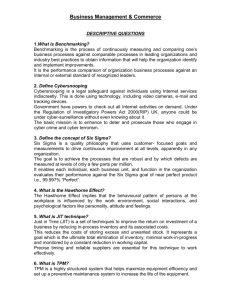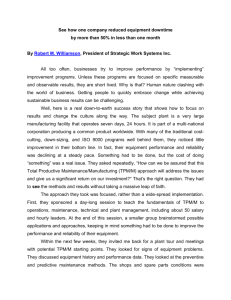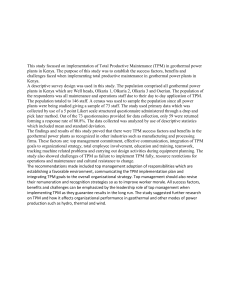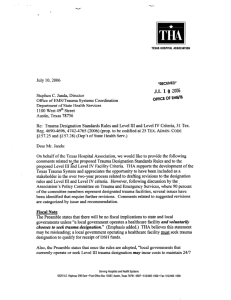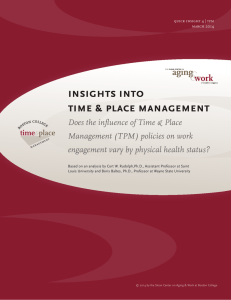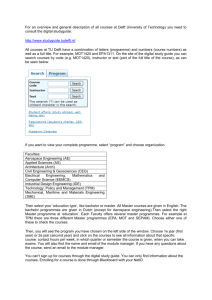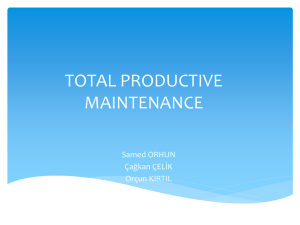insights into time & place management
advertisement
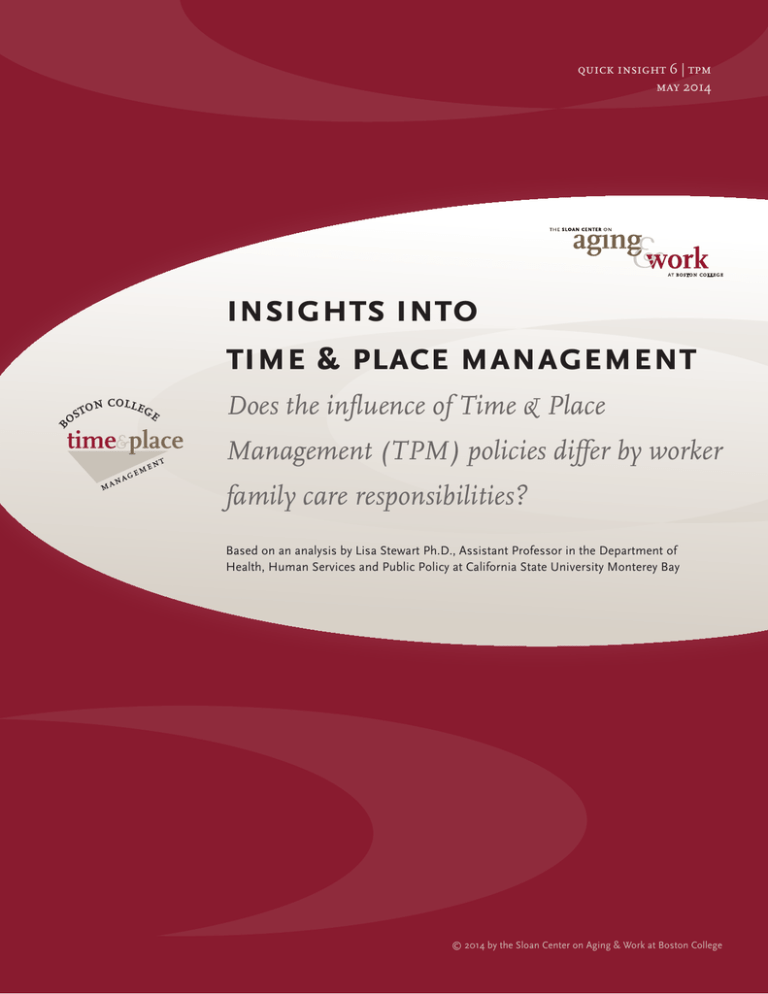
quick insight 6 | tpm may 2014 quick insight 6 | tpm may 2014 b insights into time & place management colleg ton e s o Does the influence of Time & Place Management (TPM) policies differ by worker family care responsibilities? Based on an analysis by Lisa Stewart Ph.D., Assistant Professor in the Department of Health, Human Services and Public Policy at California State University Monterey Bay agework@bc.edu 1 © 2014 by the Sloan Center on Aging & Work at Boston College about the study One of the most compelling reasons that organizations provide TPM policies is to help their employees manage family responsibilities; yet, little is known about whether these policies work as well for workers with more intense and complex care responsibilities as they do for workers with more moderate care responsibilities. For some workers, family care refers to typical care provided to school age children. For other workers, it refers to long hours spent providing care for a disabled spouse. Lisa Stewart (Assistant Professor in the Department of Health, Human Services and Public Policy at California State University Monterey Bay) used the Generations of Talent data to look at how the effects of TPM policies might differ for workers with different care responsibilities. She looked at the effects of formal TPM policies and informal TPM-related workplace supports on work engagement, organizational commitment, and job satisfaction. Care responsibilities, she argued, fall on a continuum (see Figure 1), and there is no reason to assume that TPM policies are equally effective for workers with typical care responsibilities and for workers with exceptional care responsibilities. Figure 1. Family Care Responsibilities Typical Exceptional Most childcare Most eldercare Sandwich caregiving Disability/ Chronic conditions Source: Stewart, under review. ππ Perhaps the most typical type of family care responsibility, care for minor children, includes activities such as helping children to get dressed and preparing their meals. These responsibilities decrease in intensity as children age. ππ Many types of care for older adults also fall on the typical end of the spectrum. These include providing transportation, grocery shopping, and assisting with meal preparation. These responsibilities may become more intense if the older adult’s health declines. ππ Sandwich family care refers to responsibilities combining care for minor children and care for older adults. It is closer to the end of the continuum. It can be more or less intense depending on ages of children and health of the older adult receiving care. 2 http://www.bc.edu/agingandwork Time & Place Management (TPM) policies “give employees greater options and control over where, when, how, and how much work gets done.” quick insight 6 | tpm may 2014 ππ Exceptional care responsibilities refer to care responsibilities for family members with chronic conditions or disabilities. Exceptional care falls at the other end of the continuum and is characterized by intensity, complexity and an absence of community supports. Exceptional care can include care for children with disabilities and for older adults with chronic conditions. Stewart also looked at the effect of informal TPM-related workplace supports. Supervisor and coworker attitudes toward TPM can be as important as the formal policies themselves (see Box 1). Key Insights 1. Formal TPM policies generally had positive effects for groups near the “typical” end of the family care continuum, but no significant effects for groups near the exceptional end of the family care continuum. TPM policies have positive effects on work engagement and organizational commitment for workers with care responsibilities for older adults, and positive effects on job satisfaction for workers with care responsibilities for children. TPM policies do not have significant effects on any of the three outcomes (work engagement, organizational commitment, and job satisfaction) for workers with sandwich or exceptional care responsibilities. Formal TPM policies—at least as most organizations have implemented them—may not be very effective for workers with exceptional care responsibilities. 2. Informal TPM-related workplace supports have positive effects for all groups with family care responsibilities. Informal TPM-related workplace supports, particularly supervisor support, are effective for both workers with typical care responsibilities and those with exceptional care responsibilities. Informal supports are arguably more adaptable to the specific circumstances in which workers find themselves. For instance, while it could be difficult to craft a formal flexible scheduling policy to adequately meet the needs of a worker caring for a disabled spouse and minor children, a supportive supervisor could help workers balance their family responsibilities, even if those responsibilities were relatively intense or uncommon. The Bottom Line Formal TPM policies—at least as currently implemented— are effective for workers with typical care responsibilities, but not for those with exceptional care responsibilities. Informal TPM-related workplace supports, such as a culture supportive of work-family and supervisor support, are effective for both typical and exceptional care responsibilities. agework@bc.edu 3 Box 1: TPM: Formal and informal TPM refers to arrangements that allow workers to have some choice and control over when, where, and how their work gets done. While the focus is often on formal policies, informal supports are important as well. Informal supports at work include: 4 • Supervisor support: Whether the supervisor is supportive of a worker’s family responsibilities can be critically important. They may have control over whether workers can use the policies that their organizations formally provide, and may offer other accommodations that are not part of the formal organizational policies. • Workplace culture: Workers may perceive the culture of their organization as being relatively supportive or unsupportive of their family responsibilities. For instance, in some organizations workers believe that employees are expected to put their jobs ahead of their family lives. This makes workers reluctant to use TPM policies. http://www.bc.edu/agingandwork quick insight 6 | tpm may 2014 about the sloan center on aging & work Established in 2005, the Sloan Center on Aging & Work at Boston College promotes quality of employment as an imperative for the 21st century multi-generational workforce. We integrate evidence from research with insights from workplace experiences to inform innovative organizational decision-making. Collaborating with business leaders and scholars in a multi-disciplinary dialogue, the center develops the next generation of knowledge and talent management. Since our founding, we have conducted more than 20 studies in collaboration with employers: for example, studies on “Age & Generations,” “Talent Management,” and “Generations of Talent.” Studies under way are “Assessing the Impact of Time and Place Management” and “Engaged as We Age.” The Sloan Center on Aging & Work is grateful for the continued support of the Alfred P. Sloan Foundation. Sloan Center publications are sponsored in part by CVS Caremark. For more information about the Center, please visit: http://www.bc.edu/agingandwork Contact us: Sloan Center on Aging & Work 140 Commonwealth Avenue–3 Lake Street Building Chestnut Hill, MA 02467 Phone: 617.552.9195 • Fax: 617.552.9202 agework@bc.edu Authors This “Insights Into Time & Place Management” is based on an academic paper that is currently under review. The paper was written by: Lisa Stewart, Ph.D. is an Assistant Professor at California State University Monterey Bay (Department of Health, Human Services, and Public Policy). Her areas of interest include mental health, disability-related family care, and cross-national policy analysis. Summarized by: Tay K. McNamara, Ph.D. is Co-Director of Research, Secondary Data Studies at the Sloan Center on Aging & Work at Boston College. Due to her past experience in using large datasets, she both serves as an internal consultant and to oversee research projects related to secondary data sets. Additionally, her current research projects include secondary analysis related to work in countries around the world. agework@bc.edu 5
